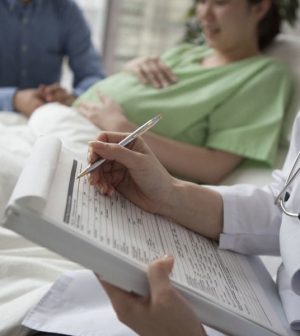- Navigating Your Midlife Crisis: Embracing New Possibilities
- City Raccoons Showing Signs of Domestication
- Mapping the Exposome: Science Broadens Focus to Environmental Disease Triggers
- One Week Less on Social Media Linked to Better Mental Health
- Your Brain Changes in Stages as You Age, Study Finds
- Some Suicide Victims Show No Typical Warning Signs, Study Finds
- ByHeart Formula Faces Lawsuits After Babies Sickened With Botulism
- Switch to Vegan Diet Could Cut Your Greenhouse Gas Emissions in Half
- Regular Bedtime Does Wonders for Blood Pressure
- Dining Alone Could Mean Worse Nutrition for Seniors
As More U.S. Women Delay Childbirth, Multiple Births May Rise

More American women than ever are having twins, triplets, quadruplets and even quintuplets, and it’s not just because some are using fertility treatments, new research shows.
Since the 1980s, the number of multiple births has jumped from roughly 20 sets per 1,000 live births to almost 35 sets per 1,000 live births, the study found.
To determine whether this was attributable to more than just a surge in the availability and use of fertility treatments, the researchers analyzed birth data from the U.S. Centers for Disease Control and Prevention that dates back to 1949 — before the advent of fertility treatments.
“Our question was: Does this social phenomenon of delayed childbearing have an impact on the incidence of multiple births in the United States?” said study author Dr. Eli Adashi. He is a professor of obstetrics and gynecology at Brown University’s Warren Alpert Medical School.
“In the paper, we showed that yes, indeed, not all the multiple births out there have to do with fertility drugs or in vitro fertilization (IVF),” Adashi said in a university news release.
“There’s a sizable proportion of multiple births that are attributable simply to delaying childbearing,” he added. “And the percentage of these spontaneous multiples seems to be growing.”
The study found that, between 1949 and 1966, by the time white women reached the age of 35 they were roughly three times more likely to have fraternal, non-identical twins. These women were also 4.5 times more likely to have triplets and quadruplets.
In addition, the findings showed that black women were four times more likely to have twins and 6.5 times more likely to have triplets and quadruplets at age 35 during that time period.
The researchers also found a notable shift in childbearing between 1971 and 2016 as fertility treatments emerged and more women made the decision to delay having children.
The study showed that the percentage of white mothers in their 30s jumped from 16 percent in 1971 to 42 percent in 2015. Black mothers in their 30s increased from 14 percent to 31 percent during this period of time.
This social trend had a significant influence on the number of multiple births, which exceeded the expected rate of about 20 multiples per 1,000 live births, the study authors said.
In 2016 alone, the decision to wait to have children accounted for 24 percent of multiple births among white women and 38 percent among black women. The researchers calculated that by 2025, delayed childbirth alone will account for 46 percent of the excess multiple births among white women and 40 percent among black women.
The findings were published in the October issue of Obstetrics & Gynecology.
The study authors pointed out that the risk for certain complications, including premature birth, is greater for mothers carrying more than one baby.
“People need to be aware of the increased risk of multiple births among the other more established concerns for advanced maternal age, such as Down syndrome, preterm birth and pre-eclampsia,” Adashi said.
More information
The U.S. National Library of Medicine has more about multiple births.
Source: HealthDay
Copyright © 2025 HealthDay. All rights reserved.










